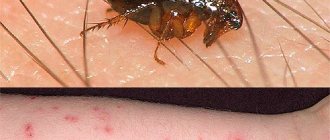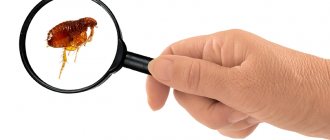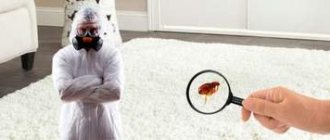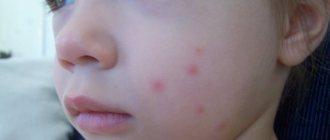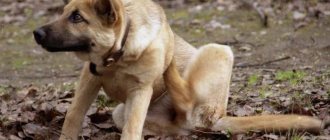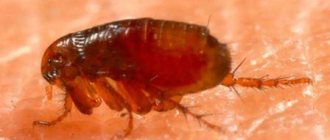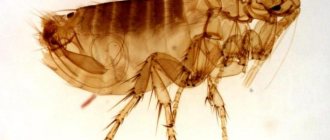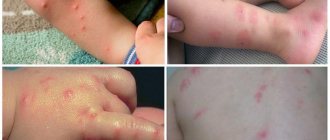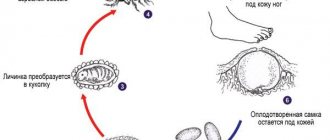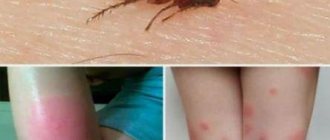Most often, pet owners encounter fleas. As a rule, they do not attach much importance to all the dangers that these insects cause to pets and people. Some people believe that dog or cat fleas do not attack people, but this is not true. In this article we will talk in detail about the existing types of fleas, their lifestyle and habitat, as well as the harm they can cause to people and animals. Here are tips on how to get rid of fleas in the house on your own using insecticides or traditional methods. Schoolchildren will be able to find many interesting points for writing an essay about fleas.
Description of fleas: lifestyle, body structure
Fleas belong to the order of blood-sucking arthropods. The length of the parasite can reach 5 mm, females after feeding grow up to 1 cm, fertilized ones - up to 1.5 cm. The body of the flea consists of a head and abdomen covered with chitinous cover, the body is flattened on the sides. Thanks to this shape, the insect easily moves among feathers, fur and clothing. Color ranges from yellow to almost black.
Interesting! During the process of evolution, many animals have changed in appearance. Scientists have found that the modern flea looks almost the same as its ancestors.
Fleas do not have wings, and they move by jumping with the help of three pairs of long and strong limbs. Some species have shorter paws, so they are constantly on the host's body. The paw consists of five segments and ends with sharp bristles-claws, forked at the end.
The flea's body is covered with spines and bristles, which helps it move very quickly throughout the victim's body. The head has serrated ridges. Due to this structure, the parasite cannot be combed out, chewed out or removed; it can only be crushed with a fingernail.
At the back of the abdomen is the pygidium, a sensory organ covered with tactile hairs. They react to small changes in air and warn of danger.
The reproductive system of the female consists of the oviduct, ovaries and spermatic receptacle (in the shape of a curved flask), and of the males - the genital claw (copulatory organ).
There are antennas behind the eyes. With them, males hold onto females during mating. The rest of the time they are in the antennal fossae.
The type of oral cavity is piercing-sucking. After biting the skin, the flea enlarges the wound, secretes saliva, which prevents blood clotting, then penetrates deeper and moves to the blood vessel, where it sucks blood. A flea cannot crawl completely under the skin.
Lifestyle
Adults differ from many other insects in having a fairly active lifestyle , which is marked by periodic settlements on the body of the prey in order to receive nutrition for further life activity.
What do fleas eat? These parasites drink blood. It is worth noting that when they are full, they most often leave the object and look for a new owner, which makes these insects potential carriers of various diseases .
for fleas to get enough food once a day , but if this process is interrupted for some reason, then they are forced to look for another source of nutrition.
How long can fleas live without food? If it is not possible to find a source of food, then a flea can survive without food for a week, or even a month . As for the host, these parasites are quite unpretentious .
Individuals that live on cats can consume the blood of a dog or human without much embarrassment. However, it is fair to note that fleas that live on chiropterans will never jump onto mammals .
Read more about the dangers of fleas for pets and people here.
Lifestyle and behavioral characteristics
Fleas can always be seen, regardless of the time of year, on the owner or in his home. The main carriers are mammals that have a nest, burrow or live in an apartment. Some types of fleas settle in nests left for a long time. Homeless animals do not have their own home, so their fleas live on their bodies all year round and breed there. Parasites suck blood, regardless of gender, from one minute to several hours. When food runs out, insects can live for a long time (months) without food, but then they attack the owner with greed.
Interesting! A flea's jump is about 100 times longer than its body length.
Habitats of fleas in the apartment
You need to understand that regardless of the type of fleas, such as “dog” or “cat” fleas. Even in the absence of pets, you can find absolutely any type of the listed parasites in your apartment. Basically, all insects of these species have an equally similar body structure and appearance; after familiarizing yourself with the main types of fleas listed above and their usual habitat, you can understand the cause-and-effect relationship of their occurrence.
Types of fleas
There are about 22 families of fleas, which include various species.
- The human flea is the most common species. A brown insect up to 3.2 mm long, jump height 30 cm, length 50 cm. It has no thoracic or head teeth. Sucks the blood of humans and animals. Carries plague pathogens and causes pulicosis. The blood is sucked for up to 20 minutes and digested for 6 hours.
- The cat flea infests all animals, even humans. Carries many infections. The larvae develop in animal fur and bedding. Body length is up to 5 mm, females are larger - up to 1.6 cm. They live up to two years.
- The dog flea lives on dogs, cats and humans. Carries flatworms and other parasites, is the keeper of the pathogens of plague, leprosy, and Marseilles fever. Size up to 5 mm, lives up to 1.5 years.
- The rat flea is recognized as the most dangerous species, carrying plague, mouse and rat tapeworm. The length of females is 2.7 mm, males - 2 mm. Color ranges from light brown to darker. Females lay eggs in rat nests.
- The Tien Shan flea, as the name suggests, lives in the Tien Shan. The fertilized female increases in length, which gives them a worm-like appearance. The length of males is 4 mm, females – 5 mm, color black. Fleas appear in winter, rising from the frozen ground onto the body of livestock. The insects soon become larger, changing color to white.
- The grass flea (up to 3 mm long) lives on trees, bushes, grass, and gets into the apartment with the help of pets. It differs from other species in the presence of wings.
- The penetrating flea (sand flea, Brazilian ground flea) is native to Haiti, Brazil. Length 1 mm, jump height up to 35 mm. The fertilized female becomes round with a diameter of up to 1 cm. Lives in dry grass, jumps on humans, birds and animals. Males drink blood, and females get under the skin of animals' legs or human nails, causing inflammation and tetanus, which leads to gangrene, amputation, and in some cases death.
There is a species called the bed flea, which lives on upholstered furniture and bed linen (another name for linen flea). They bite a person at night in the areas of the body with the thinnest skin.
Methods of movement and jumping characteristics
Fleas move in several ways. They:
- jumping;
- crawl;
- running.
Parasites cannot fly due to the lack of wings.
Jumping is the main movement option for fleas. Jumping fleas move so quickly that it is almost impossible to follow them. It seems that the insect has simply disappeared. This is understandable, because at the moment of jumping the flea reaches a speed of up to 2 m/s.
The length of a flea's jump reaches 50 cm. This distance exceeds the length of the insect's body by 120 - 150 times. The flea jumps not only far, but also high – it can cover a distance of 30 cm.
Scientists are still studying how the flea jumps. Research shows that at the moment of jumping, the insect's body contracts like a spring. Then the long muscular hind legs are used, with which the flea pushes off the surface and abruptly begins to move in the desired direction.
An interesting fact is that a hungry flea can jump non-stop for several days in search of a victim.
Where do fleas live?
Fleas live on all continents, including Antarctica, in nests and burrows, on the body of animals and humans. They are active at any time of the year.
The main hosts are warm-blooded mammals that have a home. If an animal lives in a burrow (nest), fleas attack it less often (only for feeding). Animals without shelter are a permanent habitat for parasites. Some species need to feed frequently, so they are always on the host's body. Ground fleas live closer to the floor (behind baseboards, on carpets), cat and dog fleas live on the pet’s bed.
Reproduction
How do fleas reproduce? This process is not much different from other blood-sucking parasites. The female is ready for fertilization immediately after emerging from the cocoon. One meeting with a male is enough for her to lay eggs for the rest of her life. However, for them to mature, she needs fresh blood. Therefore, immediately after copulation, she looks for a victim and will not rest until she finds it.
Fleas do not have clutches as such. They simply scatter their eggs in different directions, forcefully pushing them out of the abdominal cavity. Smooth and dry, they fall off the surface of the animal’s body and fall onto the substrate in which the larva will further develop.
The female flea lays 25-50 eggs per day. Considering that her average lifespan is from 4 weeks to 2 months, it turns out that during this period she will leave more than 1000 descendants! Such high fertility ensured that these parasites became widespread throughout the world.
Life cycle, reproduction and development of a flea
The life cycle of parasites consists of the following stages:
- egg;
- larva;
- chrysalis;
- imago (adult).
The most comfortable temperature for breeding is 18-25 degrees (then they breed all year round). In cold weather they live but do not reproduce. Before mating, partners eat. The female climbs onto the male's back and takes the genital claw into the spermatic receptacle. Mating lasts several hours, and the seed moves into the female’s body within 15 minutes.
Eggs are laid in small portions. The female ejects small white eggs from her body; they are located quite far from each other. After two weeks, they hatch into translucent larvae without legs, similar to worms. They make their way inside the nest and feed on rotting organic matter, skin epithelium, and blood residues from the excrement of their parents. After three molts, the larva becomes a pupa (it wraps itself in a silk-like cocoon). This stage lasts from 5 days to several months (it depends on the climate). When a flea emerges from a pupa, it immediately looks for its owner.
Fleas, characteristics, varieties, photos
The flea is a wingless insect with a complete metamorphosis, which implies a developmental stage consisting of three parts, namely: the egg from which the larva emerges, then the cocoon from which the pupa emerges and the last stage of transformation, from the pupa to the adult. This knowledge gives us the opportunity to recognize and exterminate the parasite at all stages of its development; often, when faced with this problem, due to incompetence, fleas can be confused with a type of insect such as bedbugs. In this case, further methods of extermination may not be suitable. Therefore, in order to avoid wasting time, we advise you, at the first stage, to familiarize yourself with the signs that will allow you to determine the type of parasite and, accordingly, choose the right method for its extermination.
The danger of fleas to humans and animals
The main danger of insects is the various infections, bacteria and diseases they carry. In the body of some species there are more than two hundred viruses and bacteria that cause fatal diseases. In addition, an allergy to flea enzymes with characteristic symptoms (inflammation, itching, fever) may develop.
What diseases are carried
Fleas can infect humans with pulicosis and sarcopsillosis. They carry:
- plague;
- typhus;
- encephalitis;
- hepatitis;
- salmonellosis;
- fungal infections and others.
Fleas suck the blood of not only healthy organisms, but also sick and dead ones. Viruses enter the blood through a bite with saliva and spread throughout the body.
Interesting! In the Middle Ages, the bubonic plague claimed the lives of many people. The source of the disease was fleas, which were brought along with rats on ships.
What does a bite entail: main symptoms
Experts have found that fleas are carriers of more than 200 dangerous bacteria and viruses. Victims of parasites may develop the following diseases:
- salmonellosis;
- brucellosis;
- Siberian plague;
- encephalitis;
- tularemia.
But most often people become infected from bloodsuckers with pulicosis, which has the following symptoms:
- enlarged lymph nodes;
- migraine;
- sleep disturbance;
- causeless irritability;
- high body temperature;
- wounds on the skin and mucous membranes that do not heal for a long time;
- rash in the area of the bite.
How do fleas bite humans?
The flea pierces the skin when it bites, causing stabbing pain and unbearable itching. At the same time, it does not secrete an anesthetic substance, but introduces enzymes that prevent blood clotting. Since the parasite does not have a proboscis like mosquitoes, it has to penetrate the layer of skin to reach a blood vessel. The bite site swells as if from a cigarette burn. After the fleas are saturated, the wounds converge, which prevents blood from escaping.
Each person reacts to a bite differently. For some, the itching goes away quickly, while for others, signs of inflammation persist for several days. With pulicosis, the skin swells, ulcers appear on the oral mucosa, and the central nervous system is affected. An allergic reaction to human bites causes fever, chills, and indigestion.
Ways to fight
Before you start fighting parasites, you should remove them from your pets. Since through them they can also penetrate into the room. If you treat the rooms, but at least 1-2 fleas live on the animal, the result will be short-lived.
Treat animals with one of the following:
- drops. Stronghold, Frontline, Hartz products have proven themselves well;
- special insectoacaricidal sprays, for example, Bars, BlochNet, Frontline, Hartz;
- shampoos: Celandine, Mr.Bruno, Beaphar. They are especially often used for cats and dogs of decorative breeds.
After flea treatment, put a special collar on your pet to prevent re-infestation.
How can you tell if there are fleas at home?
House fleas are not separate species. This is the name given to insects that have settled in an apartment. They are not detected immediately. To determine whether there are insects at home or not, you can conduct an experiment. You need to spread a white sheet on the floor and look at it after some time. Dark insects are clearly visible against a light background. Another sign of the appearance of “uninvited guests” are bite marks on the human body - red, slightly swollen spots that appear in the morning and are very itchy.
What does a blood-sucking parasite look like: description and photo
The body length of a human flea reaches 3 mm. Insects can be recognized by the following characteristics:
- flattened body shape;
- black-brown or brown color of the body;
- numerous hairs and hooks covering the limbs and body of the parasite;
- lack of wings.
To distinguish a human flea from its relatives, you will need a magnifying glass or microscope.
Externally, the insect may look like a brown seed. The photos and pictures show close-ups of what fleas (moose, rat, etc.) and their larvae look like, as well as what bites look like on human skin on various parts of the body.
How to get rid of it?
Parasites must be combated; modern drugs will help even in advanced cases. First you need to determine where the insects in the house come from. So, if fleas were brought by pets, they need to be treated. If parasites are coming from the basement or from neighbors, seal the existing cracks. To get rid of fleas at home, we recommend using modern insecticidal preparations that do not have a pungent odor and do not harm people and pets.
Chemicals
Since a flea cannot eat the bait, insecticidal preparations are produced in the form of a spray, powder, or aerosol. All means affect the nervous system of the parasite and paralyze it.
- Aerosols will help when treating a large affected area. Be sure to evacuate all residents, after the procedure, ventilate the room and do wet cleaning.
- Powders are distributed in habitats and have a long-lasting effect.
- Liquid microcapsules are not washed out after cleaning.
The most popular and effective are:
- Raptor spray, marked “against crawling insects”, has a pleasant smell;
- Combat - spray, analogue of Raptor;
- Sinuzan is a professional product with a rather unpleasant odor;
- Chlorpirimark is suitable not only for removing fleas, but also the Colorado potato beetle;
- Biorin is a professional product that destroys all existing insects;
- Dust is especially effective against parasite larvae;
- Delcid is an emulsion intended for pets;
- Pyrethrum - powder scattered in corners, poisons parasites.
After killing the insects, you need to do a wet cleaning by adding ammonia or eucalyptus essential oil to the water. It is advisable to place branches of wormwood and lavender under the bed.
External structure
The order Fleas (Fig. 99B) are wingless, small insects, 1-5 mm in size, flattened as if they were being diligently pressed from the sides. The head and chest are small, like appendages of powerful hind legs and a huge abdomen. The smooth and slippery body is lined with elastic, backward-directed bristles and hairs.
This body shape is very convenient for movement in the thick fur of mammals and the feathers of birds, where fleas live. In addition, they are excellent jumpers, able to make jumps many times greater than their body size. Thanks to this, they can quickly and deftly get onto the body of their owners, and at the same time avoid defensive actions on their part.
Parasites
Adult fleas are bloodsuckers that parasitize various mammals and birds. Each type of flea feeds on specific, preferred animals. Cat fleas feed on cats, dog fleas feed on dogs, and usually do not bite humans. However, in the absence of their owners, many fleas can temporarily parasitize both other animals and humans. Dog, cat and rat fleas have been repeatedly found on humans. This is important to know, since among them there may be carriers of pathogens of dangerous infectious diseases - plague, tularemia, rat typhus. Fleas can be intermediate hosts of some worms, for example, pumpkin tapeworm.
| Rice. 99B. Flea |
What role do fleas play in nature, are they beneficial?
Insects cannot be viewed solely in terms of whether they are harmful or beneficial to the environment. The role of some of them in nature is limited to participation in the food chain. Larger creatures survive by feeding on weaker and smaller relatives. As soon as just one link falls out of the chain, the entire food process system will collapse, which will entail serious consequences for the environment.
To be fair, it is worth noting that it is unlikely that ants will die if a component such as fleas disappears from their food supply, because they feed not only on these bloodsuckers.
https://www.doklad-referat.ru/%D0%91%D0%BB%D0%BE%D1%85%D0%B8_(%D1%81%D1%82%D1%80%D0%BE% D0%B5%D0%BD%D0%B8%D0%B5_%D0%B8_%D1%85%D0%B0%D1%80%D0%B0%D0%BA%D1%82%D0%B5%D1% 80%D0%B8%D1%81%D1%82%D0%B8%D0%BA%D0%B0) https://vreditelisos.ru/nasekomye/blohi/bloha-foto.html
On shelves and cabinets
Cat owners know that sometimes their pets can easily jump to the very ceiling. Therefore, the presence of fleas on bookshelves, kitchen furniture and other high places should not be surprising. Remember that flea eggs fall everywhere where your furry friend moves.
Forecast for solving the problem
Removing fleas on your own can take a very long time. It is worth considering that most household insecticides do not act on their eggs, and in the case of developed resistance, even on adults. The whole cycle will repeat again and again ad infinitum. If the number of insects is so large that the entire apartment is infected, then the use of a highly toxic insecticide cannot be done 100%, and, as mentioned above, it is not a fact that its one-time use will be enough (even with professional help).
